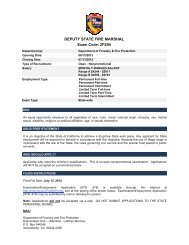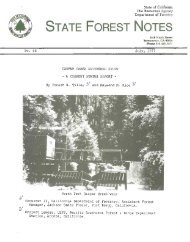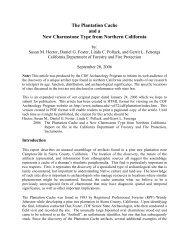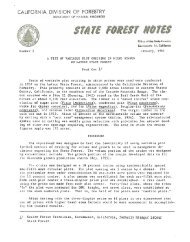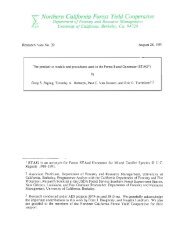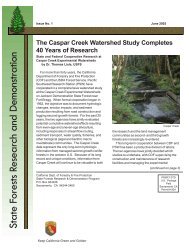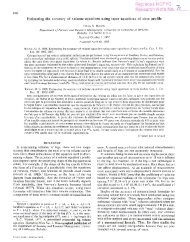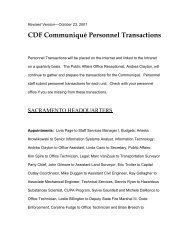CALIFORNIA FORESTRY NOTE - Demoforests.net
CALIFORNIA FORESTRY NOTE - Demoforests.net
CALIFORNIA FORESTRY NOTE - Demoforests.net
You also want an ePaper? Increase the reach of your titles
YUMPU automatically turns print PDFs into web optimized ePapers that Google loves.
,.---<br />
- - .. -.<br />
The power head contains a circular blade<br />
that has five carbide cutters. The kerf is 3/16<br />
inches. The blade can be sharpened in five<br />
minutes using a sharpener that comes with<br />
the purchase of the mill. The blade does not<br />
need to be removed from the powerhead to<br />
be sharpened, and because the new models<br />
are "electric start", the 12-volt battery can<br />
power the sharpener. A wheel attaches to<br />
the powerhead allowing it to be pushed to<br />
most sites. If this is not feasible, the various<br />
components can be arranged to enable<br />
processing flexability. For example, ropes<br />
can be attached to the powerhead frame,<br />
which is then attached to the "Zig Zag"<br />
yarder cable, and transported to the log. The<br />
saw mill frame and rails were attached to the<br />
cable with twine chokers. The "Zig Zag"<br />
yarder transported the mill to the site of the<br />
felled tree. Once the saw mill pieces<br />
reached the site they were cut from the cable<br />
and then the mill was assembled over the log<br />
to be cut.<br />
To mill lumber the saw mill operator engages<br />
the powerhead which rides on tracks that are<br />
set up around the log being milled, making<br />
either a vertical or horizontal cut. When the<br />
powerhead reaches the end of the log being<br />
milled the blade is shifted and the second cut<br />
is completed as the powerhead is pulled<br />
back to the opposite end of the log. The<br />
operator, or a second worker, pulls the board<br />
that has just been milled and stacks it. The<br />
mill is then reset for the next cut and the<br />
process is repeated.<br />
The saw mill tested can manufacture cants<br />
up to 6.25 inches by 12.5 inches, and other<br />
models are capable of manufacturing cants<br />
up to 8.5 inches by 17 inches. Slabbing bars<br />
can be purchased which allow the mill to<br />
manufacture slabs up to 6.25 inches by 50<br />
inches from the Model 6 and 8.5 inches by<br />
60 inches with the Model 8. These mills can<br />
manufacture lumber of any size that is less<br />
than the stated maximums. The standard<br />
4<br />
mills are able to cut logs that are 48 inches in<br />
diameter and 20 feet in length without moving<br />
the end frames. Much larger logs may be cut<br />
by the mill. Diameters of 8' or larger can be<br />
manufatured by resawing cants to smaller<br />
sizes. For logs longer than 20 feet contact<br />
the manufacturer to get instructions on<br />
methodology. Two or three small diameter<br />
logs can be placed under the frame and<br />
milled in a single setup. Extensions are<br />
available which permit longer logs to be<br />
milled.<br />
THE "ZIG ZAG" YARDER<br />
The "Zig Zag" is a continuous monocable<br />
yarding system, consisting of a series of<br />
blocks that are hung from trees or spars in a<br />
"Zig Zag" pattern. In the blocks are pulleys<br />
that have a toothed flange on the bottom.<br />
The blocks are hung from trees with straps,<br />
and cable tension and friction hold the blocks<br />
in place. The blocks do not cause damage to<br />
the trees.<br />
The "Zig Zag" yarder was mounted in the<br />
back of a four- wheel drive, % ton pickup<br />
truck that makes it easy to move. The power<br />
source for the yarding system is a 12<br />
horsepower gasoline fueled engine that<br />
turns a drum around which the cable is<br />
wound. The cable is a continuous loop that<br />
is set at a constant speed. The speed of the<br />
cable is adjustable and direction can be<br />
reversed.<br />
Lumber, brush, firewood, or other material is<br />
hung from the cable by a bailing-twine choker<br />
that is looped around the material and tied to<br />
the cable with a clove hitch. Experienced<br />
workers quickly tie the clove hitch with one<br />
hand. The twine passes through the blocks<br />
and when the material being yarded reaches<br />
the landing the twine is cut. When necessary<br />
to fully suspend the material being yarded,<br />
both ends of the items are tied to the cable<br />
with the twine. The weight the "Zig Zag" can




